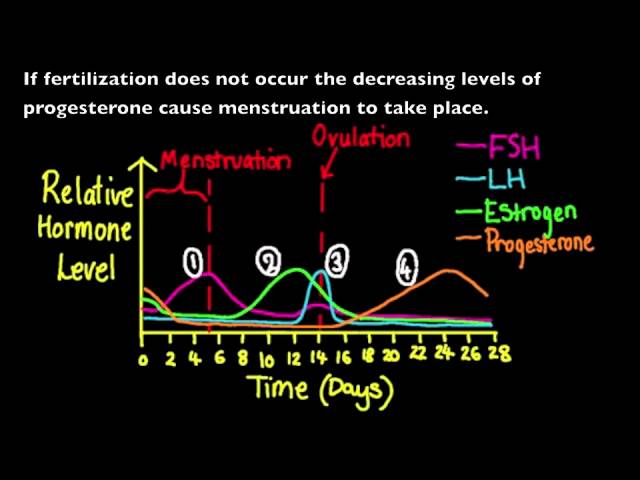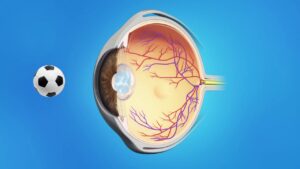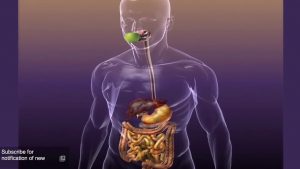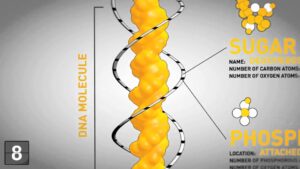6.6.3 Annotate a graph showing hormone levels in the menstrual cycle, illustrating the relationship between changes in hormone levels and ovulation, menstruation and thickening of the endometrium We begin with the hormone FSH (Follicle Stimulating hormone). 1) FSH increasing causing the ripening of the Graafian follicles and stimulating estrogen production (an example of positive feedback). 2) Increases in estrogen levels cause the repair of the endometrium and stimulate LH (Luteinizing hormone) production — this is another example of positive feedback. 3) A peak in LH levels cause ovulation (the release of the ovum from the ovary to the oviduct) and the subsequent development of the corpus luteum. The corpus luteum is a temporary endocrine structure formed after the release of the ovum from the graafian follicles. Its role is to secrete progesterone and therefore levels of progesterone increase. 4) Increasing levels of progesterone maintain the endometrium in preparation for fertilization. a. If fertilization does occur the corpus luteum continues to secrete progesterone and the endometrium lining is maintained. b. If fertilization does not occur, the corpus luteum disintegrates, therefore decreasing progesterone levels. This means the endometrium is no longer maintained and so menstruation (the loss of the endometrium) takes place. c. Since there is a negative feedback relationship between progesterone and FSH, decreasing levels of progesterone result in increasing levels of FSH and this brings us back to the beginning of the cycle where we started from.

6.6.3 Annotate a graph showing hormone levels in the menstrual cycle
- Post author:
- Post published:May 5, 2021
- Post category:Uncategorized
- Post comments:0 Comments
You Might Also Like

health related fitness components

What Losing Weight Does To Your Body And Brain | The Human Body

GLUCAGON

Lat Pull Down-10

BICEPS – DB Cross Body Hammer Curls

Amino Acids: What are they? What do they do?

How to Use Whey Protein for Weight Loss

HGH, Growth Hormones & Plant Hormones Video – 50

Natural Leg Extensions to Build Quads

Post Surgery Video – 4

How to Dumbbell Squat | Mike Hildebrandt

What is Water Circulation?

How to Do a Leg Raise | Ab Workout

Clinical Neurophysiology Video – 2

Biology: Digestive System Video

Andropause: Treating Male Hormone Imbalance Naturally (Male Menopause)

CHEST MACHINE / TUTORIAL FOR BEGINNERS – PART ONE

Sugar Free, Low Sugar Video – 24

Biceps – stability ball curls

Cardio-Thoracic Physiotherapy Video – 9

Fat Loss, Weight Loss Video – 5

Protein Supplements BCAA Amino Acid Pills vs Powder Supplements

Donkey kicks

Laser Surgeries Video – 4

How to Do Triceps Dumbbell Extensions

Brain Stroke, Types of, Causes, Pathology, Symptoms, Treatment and Prevention, Animation.
![Read more about the article HDL & Reverse Cholesterol Transport [HD]](https://videos.drmaheshkumar.com/wp-content/uploads/2021/05/HDL-Reverse-Cholesterol-Transport-HD-300x169.jpg)
HDL & Reverse Cholesterol Transport [HD]

Keto Diet, Keto Foods, Keto Recipes Video – 26

The Ab Bench Back Extension : Training & Body Sculpting

Metformin Part 2: How Does it Work?

18 Things You Should Know About Genetics
Shrugs-2

Menopause and Weight Gain Simplified | Women’s Health

One Arm Tricep Extension

Physiotherapy in Rehabilitation Video – 3

Muscle Building Workout & Squats

Surgery Books Video – 4

Bodybuilding Nutrition, Diet Recipes & Workout – 38

FAQ 1 – I’m doing exercise on regular basis and not getting the results? | Health and Fitness

Antihypertensives: volume decreasing: ACE & Diuretics (VOLUME ONLY)

Bodybuilding Nutrition, Diet Recipes & Workout – 9

